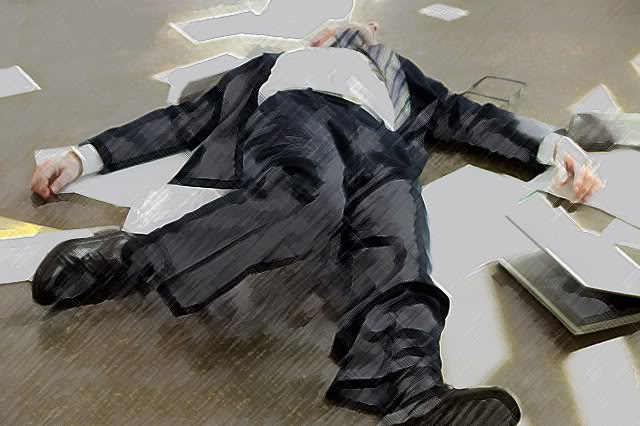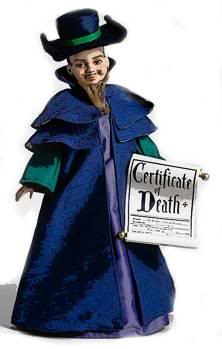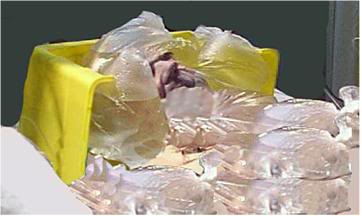By Mike Darwin
 Sudden Death and Unexpected Death: Is there a Difference and Does it Matter?
Sudden Death and Unexpected Death: Is there a Difference and Does it Matter?
Most cryonicists understand what sudden death is: it is cardiac arrest due to sudden cardiac arrest (SCA), rapidly fatal stroke, accident, homicide, and yes, even suicide. Most sudden cardiac arrests are caused by myocardial infarction (MI), with stroke and accident being the next two most likely causes. Other than sudden death, people die in one of three ways, as illustrated in Figure 1, below. Death from a chronic, progressive, fatal illness in one of the forms shown in Figure 1 is what most cryonicists expect to befall them, if they expect to die at all; being optimists, quite a few expect interventive gerontology to come to their rescue before they confront such unpleasantness. However, the reality is that it simply isn’t possible for any of us to know how, let alone when, we are going to arrest and, strange as it may seem, that applies even to those of us who are already terminally ill and “dying” now.
Which brings us to the issue of unexpected death: Unexpected death includes all forms of sudden death, but also encompasses deaths from things like cancer and other “predictable” illnesses that occurred sooner (or later) than expected, and as a consequence preclude or derail preparations made to deal with it. It is unfortunately all too common for someone who is terminally ill to either experience cardiac arrest (unexpectedly) sooner than was predicted, or to rally, live days or even months longer than was anticipated, and then arrest unexpectedly after the Standby team has stood-down or downsized dramatically. Too few cryonicists appreciate this reality, and as a consequence, many are caught unprepared.
 Figure 1: The three patterns of “predictable” death: Historically death from malignancies (pattern 1) has resulted in a relentless and comparatively predictable decline with a brief period (~2-4 weeks) of sharp decline near the end of the illness. As targeted and rationally designed pharmacological treatments for neoplasms become available over the next decade, death from cancer may become less predictable. Congestive heart failure and chronic obstructive pulmonary disease (pattern 2) are characterized by progressive disability punctuated with acute episodes of acute decompensation the outcome of which (for any given episode) is difficult or impossible to predict. The third category of patients suffering from progressive frailty (often as a result of sarcopenia, osteoporosis and diffuse deterioration in cognitive and motor faculties) or dementia (pattern 3) may arrest suddenly and without warning secondary to heart attack, stroke, or pulmonary embolism, or they may provide warning (in widely variable amounts) in the form of the refusal (or inability) to take in food and fluids, or develop pneumonia, urosepsis, or some other infectious process.
Figure 1: The three patterns of “predictable” death: Historically death from malignancies (pattern 1) has resulted in a relentless and comparatively predictable decline with a brief period (~2-4 weeks) of sharp decline near the end of the illness. As targeted and rationally designed pharmacological treatments for neoplasms become available over the next decade, death from cancer may become less predictable. Congestive heart failure and chronic obstructive pulmonary disease (pattern 2) are characterized by progressive disability punctuated with acute episodes of acute decompensation the outcome of which (for any given episode) is difficult or impossible to predict. The third category of patients suffering from progressive frailty (often as a result of sarcopenia, osteoporosis and diffuse deterioration in cognitive and motor faculties) or dementia (pattern 3) may arrest suddenly and without warning secondary to heart attack, stroke, or pulmonary embolism, or they may provide warning (in widely variable amounts) in the form of the refusal (or inability) to take in food and fluids, or develop pneumonia, urosepsis, or some other infectious process.
The take-home-message in all of this is very simple; 25% to 30% of cryonicists will arrest with little warning or no Standby team present. While it is true that the number of sudden and unexpected deaths can almost certainly be reduced among cryonicists; that is a topic for another article. As it stands now, the chances of North American cryonicists experiencing cardiac arrest without Standby, due solely to medical causes, are presented in Figure 2, below. Approximately 57% of all deaths in the US are sudden in nature with the balance, of approximately 43%, presumably being candidates for Standby and Transport. However, this presumes there are no financial or logistic barriers to your cryonics organization deploying in a timely fashion. Not considered are snow storms, hurricanes, fuel shortages, or even more mundane problems, such as traffic jams or a breakdown in the complex web of communications and logistics required to get rescue team members organized and deployed. For cryonicists living outside the US, things may be better or worse, in terms of the medical and other causes of sudden death, but beyond that, at least for now, the odds of getting rapid and effective emergency care in the event of unanticipated cardiac arrest are almost nil.

Figure 2: Approximate U.S. distribution of predictable deaths by cause based on 2004 data. Note that ~57% of all deaths occur sufficiently suddenly, or under circumstances such as accidents, which preclude standby or other cryonics stabilization measures. Chart derived from data: [National Vital Statistics Report, Volume 53, Number 5 (October 2004)].
The obvious problem with unexpected arrests is that they usually prevent Standby, and even when a response team is available locally, such emergencies invariably result in delay. Many cryonicists seem to have the same two ideas about sudden or unexpected arrest: 1) it isn’t going to happen to me, and 2) if it does, I’ll be a Coroner’s or Medical Examiner’s (C/ME’s) case and I’ll either be autopsied, or be unable to receive any emergency cryonics care until the C/ME releases me, too many hours later. The fact is, that both of these assumptions are often wrong. Cryonicists in seemingly good health, with few or even no risk factors for SCA or stroke, have arrested suddenly. Sometimes this has occurred as a result of undetected atherosclerosis, but it has also happened due to cardiac arrhythmia unrelated to coronary heart disease, and as a result of accidents, suicides and even homicides. Cryonicists have arrested as a result of falling off a ladder, being hit by an automobile while walking the dog, due to impulsive, self-inflicted gunshot wound to the chest, and from a pulmonary embolism due to a blood clot (that silently formed in the leg) suddenly breaking free and cutting off blood flow to the lungs. The unexpected is, by definition, just that; unexpected.
 In most cases of SCA, the patient becomes a C/ME case with the C/ME at least taking custody of the body and, worst case, performing a complete autopsy (including dissection of the brain). This is not the case in many instances of unexpected death where the person was terminally ill and often already enrolled in a hospice program. It is also often not the case when an elderly nursing home or hospital patient dies suddenly under unremarkable conditions. If the C/ME is contacted at all in such cases, usually he will immediately (or very quickly – 15 to 20 minutes) issue a release number and allow the patient to be “disposed of” in the same manner as if the death was outside his purview. In at least a dozen cryonics cases the C/MEs have even waived taking custody and performing an autopsy where the “death” occurred at home from SCA or in the setting of chronic illness, and in one case, even though the death was a result of a motor vehicle accident (the member was fatally struck by a car skidding on an icy street while she was walking her dog). CM/Es have enormous discretionary power and how they behave is often dictated more by their personal inclination and mood than it is by the law. A fair number of CM/Es have allowed cryonicists to pack a patient (or in some cases just his head) in ice in the morgue cooler, while others have autopsied cryopatients for no reason, other than to show their contempt for cryonics, and the people who practice it.
In most cases of SCA, the patient becomes a C/ME case with the C/ME at least taking custody of the body and, worst case, performing a complete autopsy (including dissection of the brain). This is not the case in many instances of unexpected death where the person was terminally ill and often already enrolled in a hospice program. It is also often not the case when an elderly nursing home or hospital patient dies suddenly under unremarkable conditions. If the C/ME is contacted at all in such cases, usually he will immediately (or very quickly – 15 to 20 minutes) issue a release number and allow the patient to be “disposed of” in the same manner as if the death was outside his purview. In at least a dozen cryonics cases the C/MEs have even waived taking custody and performing an autopsy where the “death” occurred at home from SCA or in the setting of chronic illness, and in one case, even though the death was a result of a motor vehicle accident (the member was fatally struck by a car skidding on an icy street while she was walking her dog). CM/Es have enormous discretionary power and how they behave is often dictated more by their personal inclination and mood than it is by the law. A fair number of CM/Es have allowed cryonicists to pack a patient (or in some cases just his head) in ice in the morgue cooler, while others have autopsied cryopatients for no reason, other than to show their contempt for cryonics, and the people who practice it.
Thus, it is not the case that all sudden or unexpected deaths invariably end in the CM/E’s office with “hopelessly” long delays until meaningful emergency care can be started or with no possibility of beneficial intervention because of autopsy. In those cases where cryonics first aid is possible, the quality of that care can make a huge difference in the amount of damage the patient sustains. My purpose here is to lay out a variety of things that you can do to improve your readiness in such an emergency, ranging from fairly simple and inexpensive things, to more complicated and costly preparations. All of the things I will be discussing in these articles will provide stand-alone benefit. In other words, each one will work to improve your chances independently of the others. At the same time, these preparations are largely synergistic, in that when used together, they will help reduce the amount of damage you are likely to sustain if you arrest absent a skilled cryonics team waiting in the next room.
Defining Death?
“[Determination of Death.] An individual who has sustained either (1) irreversible cessation of circulatory and respiratory functions, or (2) irreversible cessation of all functions of the entire brain, including the brain stem, is dead. A determination of death must be made in accordance with accepted medical standards.”
– Uniform Determination of Death Act as proposed by the National Conference of Commissioners on Uniform State Laws, May, 1980.
“Theoretically, even destruction of an organ does not prevent its functions from being restored. Any decision to recognize “the end” is inevitably restricted by the limits of available medical knowledge and techniques. Since “irreversibility” adjusts to the times, the proposed statute can incorporate new clinical capabilities. Many patients declared dead fifty years ago because of heart failure would have not experienced an “irreversible cessation of circulatory and respiratory functions” in the hands of a modern hospital.”
– Defining Death: A Report on the Medical, Legal and Ethical Issues in the Determination of Death prepared by the President’s Commission for the Study of Ethical Problems in Medicine and Biomedical and Behavioral Research
In The Uncertainty of the Signs of Death and the Danger of Precipitate Interments in 1740, Jean-Jacques Winslow advanced the proposition that putrefaction was the only sure sign of death.
The Problem of Pronouncement
 As Coroner, I must aver
As Coroner, I must aver
I thoroughly examined her
And she’s not only MERELY dead,
She’s really, most SINCERELY dead.
—Coroner, after examining the remains of the Wicked Witch of the East, from the film The Wizard of Oz, 1939.
Despite its obvious importance and its restriction to the medical and law enforcement professions (coroners are typically peace officers, and have full police authority) both the criteria and the specific procedures used to pronounce death are surprisingly casual and ill defined. While U.S. law governing the minutiae of who may legally pronounce death varies somewhat from state to state, in general the authority to pronounce, or legally declare death, is reserved for physicians, C/ME’s and their deputized or authorized personnel, and in many states, registered nurses participating in an authorized hospice program. A search of medical textbooks, peer-reviewed publications, hospital, extended care facility, and even hospice standard operating procedure (SOP) manuals reveals a striking absence of standardized protocols for diagnosing death. In fact, to find any documented or specified procedure at all is the exception, rather than the rule.
A singular problem with cryonics last aid is that the patient actually be clinically dead, and not a candidate for resuscitation before any last aid procedures are applied. In circumstances where an attending physician, nurse, or other legally authorized person has pronounced death and the patient is not a C/ME’s case, there should be no problem with carrying out the last aid procedures described in these articles. This will particularly be the case in situations where the patient is wearing a medical alert bracelet (and possibly a medical jump drive) with instructions to carry out these procedures (i.e., pack in ice, administer CPR, and so on). In cases where medico-legal death has not been pronounced, the application of last aid carries with it unknown and possibly serious risks. In such situations it will be up to the member (now patient) and to those around him in positions of authority to decide whether the risk of proceeding outweighs the potential benefit.
While it may seem easy to objectify this decision, in fact it is a highly personal decision and one which ideally should take into account the particulars of the situation at hand; particulars which are often impossible to predict in advance. Since the first cryonics case in 1967 there have been at least 20 instances where one or more a last aid maneuvers have been carried out prior to the legal pronouncement of death. None of these cases resulted in either medical or legal problems. However, this is not a guarantee that such problems could not occur in the future. In order to make an informed decision about applying last aid measures in the absence of legally certified death it is necessary to understand the risks. Those risks, in order of seriousness, are that:
a) The authorities (physician, nurse, C/ME, other peace officer, or even the prosecutor, decide that the patient was not medically dead (i.e., “irreversible” cardiopulmonary arrest) before last aid procedures were started and that some or all of such procedures either caused or hastened death.
b) The authorities are concerned that last aid procedures may have been initiated before medical death occurred and that an autopsy is necessary to resolve the issue.
c) The authorities believe that the patient was a candidate for resuscitation and, while not disputing the absence of cardiopulmonary function, decide that CPR and activation of the emergency medical system (EMS) by calling 911 should have been undertaken.
d) One or more empowered authorities are irritated, offended, or threatened by cryonics in general or last aid procedures in particular, and decide that they are ground for either declaring the patient a C/ME’s case or for carrying out a post mortem examination.
Individual circumstances will have a great deal to do with whether last aid is prudent , not the least of which will be the temperament and prejudices, as well as the formal policies and procedures, of the relevant authorities. To the extent possible, members should investigate these factors in advance, and at regular intervals, being mindful that CM/E’s are elected or appointed officials, and that they remain in office for highly variable periods of time. It is also important to realize that CM/Es are not in the office round the clock, 365 days a year, but rather have chief deputies and executives under them who are empowered to act in their stead. Discussing your cryonics arrangements and the last aid measures you wish carried out with these legal authorities is of paramount importance – especially in the event you charge those around you with the responsibility of acting before medico-legal death occurs. The same injunction to determine the “lay of the land” with regard to cryonics and last aid measures, also applies to your primary care physician, and to other members of your healthcare team who may have responsibility for you when medico-legal death occurs.
 Beyond the disposition of these professionals, the circumstances under which arrest occurs will likely have a profound bearing on the advisability of undertaking even the simplest last aid measures. In the past, elderly members in poor health or who suffered from well documented coronary artery disease have arrested suddenly only to be discovered by friends or family beyond the window where resuscitation was possible, or in situations where explicit, written instructions were in place that neither CPR nor defibrillation were desired by the member in the event of cardiac arrest. In some of these situations close friends or family members have honored the patient’s wishes and packed the patient’s head in ice prior to medico-legal pronouncement. This has been especially beneficial (and understandable) in rural environments where there would be a long delay between calling EMS personnel and their arrival on the scene. In other instances patients have been packed in ice (head) after EMS personnel arrived, but before formal pronouncement of death. In still other cases patients have received more sophisticated last aid, including CPR and more extensive icing in the interval between cardiorespiratory arrest and the arrival of the home hospice nurse or family physician that is authorized to pronounce medico-legal death.
Beyond the disposition of these professionals, the circumstances under which arrest occurs will likely have a profound bearing on the advisability of undertaking even the simplest last aid measures. In the past, elderly members in poor health or who suffered from well documented coronary artery disease have arrested suddenly only to be discovered by friends or family beyond the window where resuscitation was possible, or in situations where explicit, written instructions were in place that neither CPR nor defibrillation were desired by the member in the event of cardiac arrest. In some of these situations close friends or family members have honored the patient’s wishes and packed the patient’s head in ice prior to medico-legal pronouncement. This has been especially beneficial (and understandable) in rural environments where there would be a long delay between calling EMS personnel and their arrival on the scene. In other instances patients have been packed in ice (head) after EMS personnel arrived, but before formal pronouncement of death. In still other cases patients have received more sophisticated last aid, including CPR and more extensive icing in the interval between cardiorespiratory arrest and the arrival of the home hospice nurse or family physician that is authorized to pronounce medico-legal death.
In all such cases it is absolutely essential that if a decision to proceed with any form of last is made, that the patient’s condition of “irreversible” cardiorespiratory arrest be systematically and thoroughly documented prior to proceeding with any last aid measures. The first step in such documentation is to establish unequivocal evidence of irreversibility in the form of written instructions from the patient that he not be resuscitated in the event of cardiopulmonary arrest, that the patient has unequivocal injuries (decapitation/dismemberment) or postmortem signs that would preclude resuscitation (such as the presence of rigor mortis, livor mortis, or evidence of decomposition), or that the patient has failed medically sanctioned resuscitation (failed effort by EMS to achieve resuscitation on the scene). Written directions not to resuscitate, failed resuscitation and the presence of clearly lethal injuries or postmortem changes are the only true signs of irreversible cardiopulmonary arrest. Cardiopulmonary arrest in all other situations constitutes a prognosis of death, not its diagnosis.
